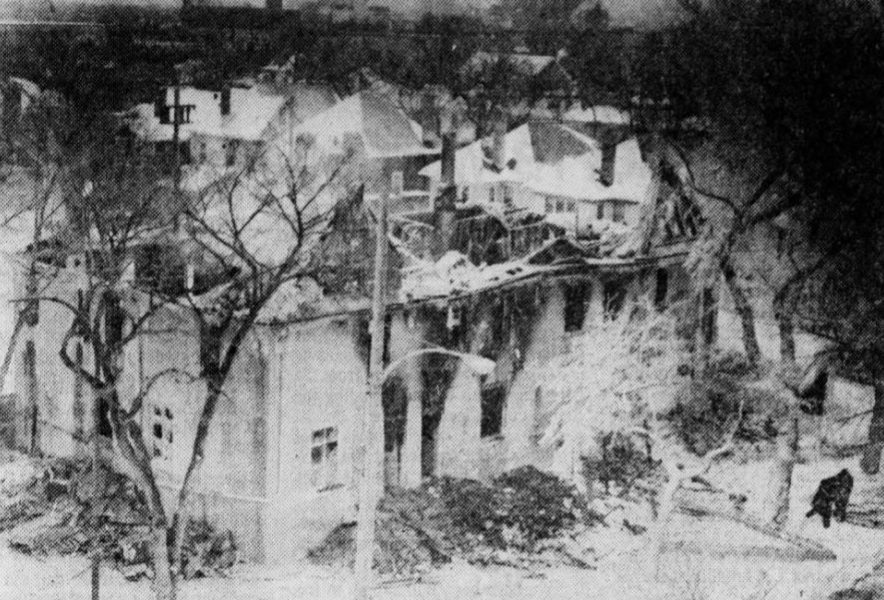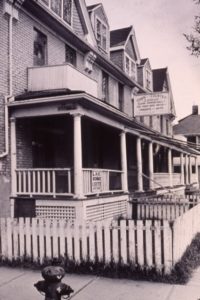
by Doug Smith
The City of Winnipeg’s reluctance to directly address low-income housing needs continued into the 1970s and 1980s. In October 1976, Winnipeg City Council appointed an ad hoc advisory committee on housing. In April 1977, the committee recommended the creation of a civic non-profit housing corporation that would purchase and renovate older houses and then either rent or resell them.[1] In June 1977, council gave unanimous approval in principle to the establishment of the Winnipeg Housing Rehabilitation Corporation that, it was projected, would renovate just under 400 homes over a five-year period. The provincial government was prepared to provide up to $1-million in funding for the purchase of houses that would be resold. In addition, the federal Central Mortgage and Housing Corporation would provide funds for the purchase of housing to be sold along with a loan of $5,000 a unit to pay for renovation. It was thought the program would cost the city $20,000 a year.[2] Paul Dube, the director of the Neighbourhood Services Centre, noted that the demand for low-cost housing was so great it would be possible to fill 400 homes overnight.[3] A 1977 report prepared for the city showed that over the previous five-and-a-half-year period 1,700 apartment units had been closed or destroyed. Landlords demolished 584 apartment units rather than comply with building code orders.[4] In 1979 landlords were still threatening to close buildings rather than install smoke detectors.[5]
The need for compliance with safety regulations and rehabilitation had been underscored by a series of deadly and near-deadly fires. Early in the morning of January 31, 1977, Winnipeg firefighters were called to a horrifying scene at 877 Preston Avenue. The aging Town and Country Lodge was ablaze, people were screaming from upper-story windows that the fire escape was blocked. One man was hanging from the eavestrough. Some jumped from the second- and third-story suites to save their lives. In one case, a distraught mother had no choice but to throw her infant child into the cold night air. There were no more than two rooms to a suite, and in some cases up of five people were living in a suite. Twenty-four of the building’s 31 suites were occupied by families receiving city welfare payments. As one survivor said, “Most of the people living there had been sent there.” Eight people, including an 18-month-old girl, died of carbon-monoxide poisoning, an additional seventeen people were hospitalized, several with broken bones. Two months after the fire, one of the survivors was still paralyzed.

The building has been constructed in 1906, originally serving as a boarding house for out-of-town families who had relatives being cared for in the Grace Hospital, which was then located on Evanson Street. It was later converted into a 31-unit building. The city had ordered extensive improvements in 1971 and in 1975 it ordered the building be temporarily shut down as being unfit for habitation. A subsequent inquest was unable to determine the cause of the fire, although the likely suspects were either careless smoking, poor wiring, or a defective heating system. The province’s chief medical officer said that high death toll was in part attributable to the fact that the building did not have smoke detectors. The inquest cast a light onto the Byzantine nature of the city’s classification system, under which the Town and Country apparently fit into none of the official categories. Because the building had been informally classified as a “terrace” it did not require third-storey exits or smoke detectors. There were four fire extinguishers in the basement, all defunct. In response to the inquest’s criticisms, the city extended its apartment safety bylaw to all residential buildings except single-family homes and duplexes. The fire underscored the need to rehabilitate older housing in the city.
The Town and Country fire was only the latest is a series of devastating fires to hit older Winnipeg apartment blocks that year. Five people had died in the February 1976 fire at the Fort Garry Court apartments, while three other apartment buildings had been destroyed by fire in January 1977. At the Town and Country inquest, city officials said it would take them a decade to inspect all of the city’s apartment buildings.[6]
The defeat of Ed Schreyer’s New Democratic Party government in October 1977 by a provincial Conservative party committed to reducing public-sector spending placed the Winnipeg Housing Rehabilitation Corporation’s future in jeopardy. However, after a considerable delay, the provincial government indicated it would honour the Schreyer government’s commitment of $1-million over five years.
A new threat then emerged instead from council itself. In December 1978, city councillor Jim Ernst, a leading member of the Independent Citizens’ Election Committee (ICEC), launched a campaign that culminated in the corporation’s dissolution. Ernst said the city should leave housing to senior levels of government and restrict its efforts to basic services. Among the councillors who supported Ernst’s proposal was future Conservative premier Gary Filmon. Another councillor, George Provost, said that people who were in housing need had only themselves to blame: “They are just too damn lazy—they’ve been on the public dole too long.”[7]

Throughout 1979 veteran Communist city councillor Joe Zuken and newly elected NDP councillor Cyril Keeper campaigned, little success, for the housing corporation’s revival.[8] The death of Conservative mayor Robert A. Steen in the spring of 1979 led to a series of byelections that changed the complexion of council. Bill Norrie, one of the more liberal members became mayor, and he was succeeded on council, by Bill Neville, a very red Red Tory. Harold Macdonald, an Anglican minister, replaced a councillor who had been elected to the provincial legislature. While they were elected with the support of the business-oriented ICEC, Neville and Macdonald supported municipal housing rehabilitation.[9] Just days after Neville and Macdonald’s election to council Norrie brought forward a motion intended to revive the housing corporation. His decision was bolstered by a recently released Institute of Urban Studies report that despite the fact the renovation was often economically more efficient than new development, there was no government agency with a mandate to rehabilitate housing.[10]
After a very contentious debate, in which Norrie stated that housing was the most important issue facing the council, the vote on the mayor’s proposal resulted in a 15-15 tie. Norrie, who had voted for the proposal, then cast a second, tie-breaking vote in the corporation’s favour.[11] The following day, provincial urban affairs minister Gerry Mercier and a former ICEC councillor said the province’s 1978 financial offer had lapsed and the money had been re-allocated.[12]Three months later, the provincial government reversed its decision, announcing that the funding for the corporation would be forthcoming.[13]

The WHRC got off to an inauspicious start. Its initial stock of housing was made of a number of residences the city had acquired as the result of tax sales. These were invariably in very poor condition, and often not worth renovating. Rather than evict the tenants, the city continued to rent the units, but did not upgrade them, in the process earning itself a reputation as a slum landlord.[14] Over time, the corporation began buying and renovating properties. In 1984 the corporation reported to have renovated 111 units that were being rented on a rented-geared-to-income basis.[15]Shortly, thereafter the Manitoba government withdrew its core funding. The city increased its operating grant to $30,000 but was not prepared to provide capital funding.[16] From then on, the WHRC operated much the same as any other non-profit housing corporation of the era, creating housing on the basis of its success in gaining project funding from CMHC. After a decade in operation, it had established 400 units of housing. According to Tom Carter and Ann McAfee’s 1990 assessment of the corporation, the city had no social housing policy or strategy to support the corporation’s work.[17]
Sources
Carter, Tom and Ann McAfee. “The Municipal Role in Housing the Homeless and Poor.” in Housing the Homeless and Poor: New Partnerships Among the Private, Public and Third Sectors. George Fallis and Alex Murray, editors. Toronto, University of Toronto Press, 1990, 227–262.
McKee, Christine, Stewart Clatworthy, and Sybil Frenette. Housing: Inner City Type Older Areas. Winnipeg: Institute of Urban Studies, University of Winnipeg, 1979.
Newman, Lynda H. Municipal Non-Profit Housing: Winnipeg Housing Rehabilitation Corporation, Occasional Paper No. 13. Winnipeg: Institute of Urban Studies, University of Winnipeg, 1986.
References
[1] “Group will urge city to back low-cost houses,” Winnipeg Free Press, 29 April 1977.
[2] “Councillors okay 5-year housing plan, Winnipeg Free Press, 2 June 1977.
[3] “Warning issued on housing blight,” Winnipeg Free Press, 13 June 1977.
[4] “Apartment loss discussion delayed,” Winnipeg Free Press, 5 December 1978; Ingeborg Boyens, “City might abandon housing involvement,” Winnipeg Free Press, 12 December 1978.
[5] “City warned of resistance to fire bylaw,” Winnipeg Free Press, September 11, 1979.
[6] “Fire kills 8; careless smoker cited,” Winnipeg Free Press, 31 January 1977; “Tenants say escape bolted; baby thrown from upper window,” Winnipeg Free Press, 31 January 1977; Debbie Sproat, “Burned bodies delay identification of eight killed in Preston Avenue fire,” Winnipeg Free Press, 1 February 1977; Pat Zanger, “Inquest told smoke detectors needed, Winnipeg Free Press, 15 March 1977; Pat Zanger, “Officials debate responsibility at Preston fire inquest,” Winnipeg Free Press, 22 March 1977; Pat Zanger, “Preston block owners couldn’t get fire insurance,” Winnipeg Free Press, 5 April 1977; Pat Zanger, “City gets blame,” Winnipeg Free Press, 7 April 1977; Cecil Rosner, “City tightens residential safety bylaws,” Winnipeg Free Press, 7 April 1977.
[7] Susan Ruttan and George Jacob, “Inner City’s decay may prompt action,” Winnipeg Tribune, 5 October 1978; “Gov’t. funds core housing corp.,” Winnipeg Free Press, 3 November 1978; “Apartment loss discussion delayed,” Winnipeg Free Press, 5 December 1978; Ingeborg Boyens, “City might abandon housing involvement,” Winnipeg Free Press, 12 December 1978; Ingeborg Boyens, “No-action policy on housing wins endorsement,” Winnipeg Free Press, 15 December 1978; Ingeborg Boyens, “No-action policy on housing wins endorsement,” Winnipeg Free Press, 15 December 1978; Ingeborg Boyens, “Non-profit housing scheme scrapped,” 21 December 1978.
[8] Ingeborg Boyens, “City councillors debate involvement in housing,” Winnipeg Free Press, September 11, 1979.
[9] Ron Campbell and Tom Goldstein, “Byelection victories give ICEC majority,” 5 December 1979.
[10] Christine McKee, Stewart Clatworthy, and Sybil Frenette, Housing: Inner City Type Older Areas, Winnipeg: Institute of Urban Studies, 1979, 52.
[11] Ron Campbell, “Norrie’s second vote saves city housing scheme,” Winnipeg Free Press, 6 December 1979.
[12] “Mercier says offer to fund city housing plan expired,” Winnipeg Free Press, 7 December 1979.
[13] John Bertrand, “Gov’t boosts housing aid by $1 million,” Winnipeg Tribune, 21 March 1980; “Province aids core housing,” Winnipeg Free Press, 21 March 1980.
[14] Cecil Rosner, “City-owned houses ruined by neglect,” Winnipeg Free Press, 26 August 1982; Fred Youngs, “City rejects ‘slum’ allegations,” Winnipeg Free Press, 3 September 1982.
[15] “Housing efforts hampered,” Winnipeg Free Press, 28 December 1984.
[16] Lynda H. Newman, Municipal Non-Profit Housing: Winnipeg Housing Rehabilitation Corporation, Occasional Paper No. 13, Winnipeg: Institute of Urban Studies, University of Winnipeg, 1986, 20.
[17] Tom Carter and Ann McAfee, “The Municipal Role in Housing the Homeless and Poor,” in Housing the Homeless and Poor: New Partnerships Among the Private, Public and Third Sectors, George Fallis and Alex Murray, editors, Toronto, University of Toronto Press, 1990, 236–237.
